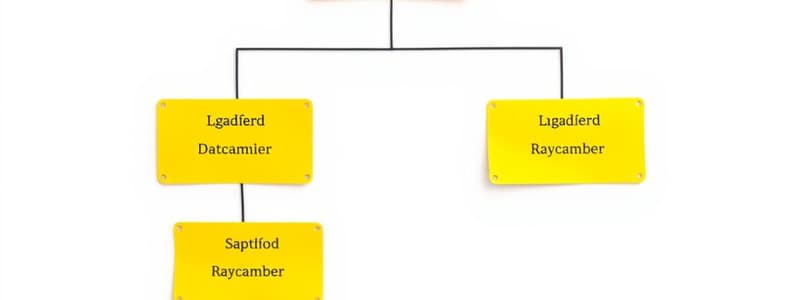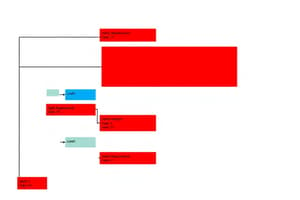Podcast
Questions and Answers
Which attribute classification must always have a value for every instance associated with it?
Which attribute classification must always have a value for every instance associated with it?
- Optional Attribute
- Derived Attribute
- Composite Attribute
- Required Attribute (correct)
What distinguishes composite attributes from simple attributes?
What distinguishes composite attributes from simple attributes?
- Composite attributes have meaningful component parts. (correct)
- Composite attributes cannot have parts.
- Composite attributes are derived from other attributes.
- Composite attributes are always single-valued.
Which of the following is an example of a multivalued attribute?
Which of the following is an example of a multivalued attribute?
- A person's name
- A person's birth date
- A person's mailing address
- A person's phone numbers (correct)
Which of the following describes derived attributes?
Which of the following describes derived attributes?
What type of attribute allows for an instance to have zero or more values?
What type of attribute allows for an instance to have zero or more values?
What are the three main constructs used in an Entity Relationship (ER) Diagram?
What are the three main constructs used in an Entity Relationship (ER) Diagram?
Which of the following best describes a data entity in an ER Diagram?
Which of the following best describes a data entity in an ER Diagram?
In the context of ER Diagrams, what does an attribute represent?
In the context of ER Diagrams, what does an attribute represent?
What is the primary purpose of relationships in an ER Diagram?
What is the primary purpose of relationships in an ER Diagram?
Which model is commonly used in the notation of ER Diagrams?
Which model is commonly used in the notation of ER Diagrams?
What does the term 'association' refer to in an ER Diagram?
What does the term 'association' refer to in an ER Diagram?
What component of an ER diagram serves as a connector between entities?
What component of an ER diagram serves as a connector between entities?
What does a Crow’s Foot notation represent in an ER Diagram?
What does a Crow’s Foot notation represent in an ER Diagram?
What is the purpose of a time stamp in data management?
What is the purpose of a time stamp in data management?
What distinguishes multivalued attributes from derived attributes?
What distinguishes multivalued attributes from derived attributes?
What characteristic does the time stamp attribute exhibit?
What characteristic does the time stamp attribute exhibit?
Which of the following statements about identifiers is true?
Which of the following statements about identifiers is true?
Why is modeling time-dependent data considered important?
Why is modeling time-dependent data considered important?
In an E-R diagram with an associative entity, what does it primarily indicate?
In an E-R diagram with an associative entity, what does it primarily indicate?
When choosing identifiers, which of the following criteria should be avoided?
When choosing identifiers, which of the following criteria should be avoided?
What is a derived attribute?
What is a derived attribute?
What is meant by cardinality constraints in a ternary relationship?
What is meant by cardinality constraints in a ternary relationship?
Which of the following is an example of a multivalued attribute?
Which of the following is an example of a multivalued attribute?
Which type of identifier is characterized by being a combination of multiple attributes?
Which type of identifier is characterized by being a combination of multiple attributes?
What is the primary advantage of using simple keys instead of long composite keys for identifiers?
What is the primary advantage of using simple keys instead of long composite keys for identifiers?
Why should identifiers ideally not contain intelligent identifiers?
Why should identifiers ideally not contain intelligent identifiers?
What term describes the number of entity types that participate in a relationship?
What term describes the number of entity types that participate in a relationship?
Which relationship type involves only one entity related to itself?
Which relationship type involves only one entity related to itself?
In a one-to-many relationship, how many entities can be related on the 'one' side?
In a one-to-many relationship, how many entities can be related on the 'one' side?
What type of relationship is characterized by each entity on one side being related to many entities on the other side, and vice versa?
What type of relationship is characterized by each entity on one side being related to many entities on the other side, and vice versa?
Which of the following is NOT a degree of relationship?
Which of the following is NOT a degree of relationship?
What is the key characteristic of a binary relationship?
What is the key characteristic of a binary relationship?
Which relationship can have attributes of its own?
Which relationship can have attributes of its own?
In cardinality terminology, which statement is TRUE regarding a one-to-one relationship?
In cardinality terminology, which statement is TRUE regarding a one-to-one relationship?
Flashcards are hidden until you start studying
Study Notes
Entity Relationship (ER) Diagram
- Represents entities, associations, and data elements for an organization.
- Composed of three main constructs: Data entities, Relationships, Attributes.
- Two commonly used notation models: Chen Model and Crow's Foot Model.
Key Constructs in ER Diagrams
- Entity: A real-world person, place, object, event, or concept about which data is maintained.
- Relationship: Association between instances of two or more entity types.
- Attributes: Properties or characteristics of an entity or relationship.
Attributes Classifications
- Required vs. Optional Attributes: Required must have a value; optional may not have a value.
- Simple vs. Composite Attribute: Composite has meaningful components (e.g., address).
- Single-Valued vs. Multivalued Attribute: Multivalued can have more than one value (e.g., multiple skills).
- Stored vs. Derived Attributes: Derived values are calculated from related attributes, not physically stored.
Identifiers (Keys)
- Identifier: Attribute or combination of attributes that uniquely identifies instances of an entity type.
- Candidate Identifier: An attribute that meets the criteria to function as a key.
- Criteria for identifiers include stability (value won't change) and non-null properties.
Degree of Relationships
- Unary Relationship: One entity relates to itself.
- Binary Relationship: Two different entity types relate.
- Ternary Relationship: Three different entity types relate.
Cardinality of Relationships
- One-to-One: Each entity has exactly one related entity.
- One-to-Many: One entity can relate to many, while the other relates to one.
- Many-to-Many: Entities on both sides can relate to many on the other side.
Relationship Examples
- Unary relationships link one entity type to itself.
- Binary relationships connect two different entity types.
- Ternary relationships involve connections among three different entity types.
Additional Concepts
- Time-stamping: A time value associated with data indicating when events occurred.
- Example of composite and multivalued attribute: Price History can contain multiple values and components.
- Importance of modeling time-dependent data due to regulations like HIPAA and Sarbanes-Oxley.
Studying That Suits You
Use AI to generate personalized quizzes and flashcards to suit your learning preferences.




